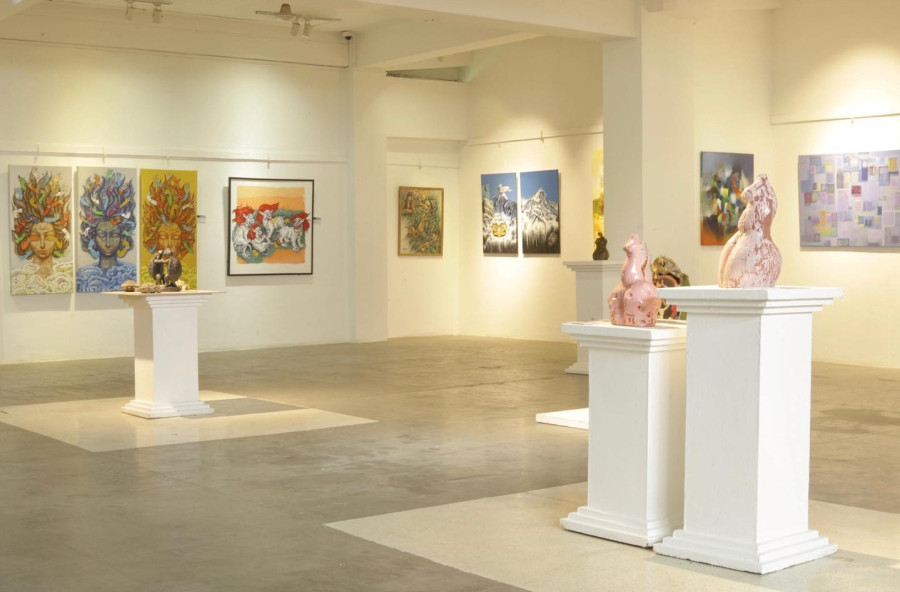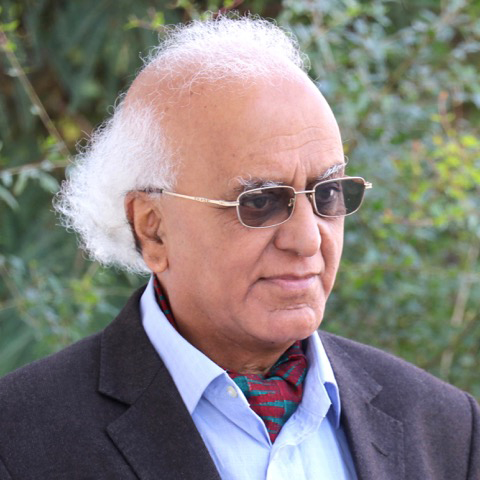Columns
The many dimensions of Nepali art
The paintings of younger artists show some features that are very encouraging.
Abhi Subedi
It was a revealing experience to visit the Himalayan Art Festival organised by E-Arts Nepal from September 26-30 at the Nepal Art Council. About 150 works of art put under different rubrics according to their mediums were on display. The exhibition provided a number of things for viewers and art lovers. These activities organised by the younger generation of artists, mostly painters, open up multiple perspectives of art in general and Nepali art in particular. But this exhibition struck me as something different because of a number of reasons. It was organised by the same group of the young generation of artists who have been doing the rounds of art exhibitions.
The most interesting part of it is that these artists play different roles in this art activism. In their exhibitions they include artists who paint, print through intaglio medium, sculpt and create short-term installation arts. These are regular activities that they have been doing. But what I found interesting is their desire and initiative to expand the horizon of art activism through the dissemination of their efforts. They organise discourses and interactional programmes, and create an audio-visual system for that. This shows how the active painters themselves want to expand art from one level of activity to another, which is academic as summed in my previous article.
Act of integration
They also want to introduce artists of different generations, musicians and poets through what they claim as "inclusive" and "holistic" approach. These are overused terms in the field of art and literature. But the real test of the artist-activists lies in the very act of integration. Only an established institute of art can make some achievements in this area. But obviously, there are problems on that front also. Moreover, the question of creating an audience and drawing the attention of the government and parties, who are not open to such matters because their minds are occupied with hectic factional activities, is challenging.
Creating a culture of participation in a cohort of creative minds and activists is a complex subject. Well-known curator Sangita Thapa, the main organiser of international art festivals in different years, has taken up the cudgel to achieve some kind of balance on this score. Her above-mentioned internationally known art festivals are part of that. But to me, her small efforts made on a regular basis to bring artists and audiences together at the Siddhartha Art Gallery are very important and significant.
The organisers of the Himalayan Art Festival, most of whom are well-known artists like Erina Tamrakar, Susan Shrestha, Asha Dangol, Bhairaj Maharjan, Pramila Bajracharya, Pradip Bajracharya and Binod Pradhan, have made some important achievements in bringing audiences and artists together. They have worked in tandem with other galleries, traditional artists and photographic groups. Asha Dangol, coordinator of the Himalayan Art Festival, said their methodology is one of creating an interart culture for which reason they had invited musical and theatrical groups to perform. That is a good effort. Interart as a subject has long found space in our university curricula at the English Department. Individual artists and painters do not necessarily have time to create such a culture because that requires careful effort to bring artists and scholars together. What I appreciate about these artists is their efforts for several years to engage in interart activism. I too being an occasional participant in their activities can say that with confidence. The Covid-19 pandemic hampered some of these activities, but it is heartening to see it taking original shape.
I only want to mention the nature of the cohort that this festival has created. For reasons of space, I have not mentioned the names of many artists here. I only want to write about my impression of visiting the exhibition on September 29. The cohort of the intergenerational artists' works and some very consummate and remarkable fine works of different mediums are the two aspects of the big exhibition that struck me. Among the rich varieties of works of artists of the young generation, the paintings of senior artists jumped to my eyes. Sashi Shah's nine stallions marking the nine manifestations of the goddess during the Dashain festival first caught my eye. Then I noticed the works of several senior artists like Krishna Manandhar, Ragini Upadhyay, Sashikala Tiwari, Kiran Manandhar and others. I have no space to write the names here, but there was a good representation of the artists of different generations.
Intaglio or print medium is the other feature that is very impressive. Block prints are very fine works. The growing interest of artists in creating consummate works is what impressed me very much. Small sculptural works placed randomly show another area where artists are striving to create diversity. The paintings of younger artists show some features that are very encouraging. That shows their propensity for creating careful and good paintings, which indeed is a growing trend in the paintings of the younger generation. I guess that is the impact of the growing art education at different art institutes, some affiliated with different universities and others growing independently. I have yet to make a careful study in this area. But my belief is that the growing activity of bringing art education and artists' personal innovations together is the new trend in Nepali art. But this is an area that should be properly studied to promote academic studies for which, as I have said earlier, interest is growing.
Overall activism
This exhibition is part of the overall activism that is growing these days in Nepal. It is always a challenge to bring the kind of art works to the fore for which the activism like that initiated by groups of individual artists like E-Arts Nepal and those of others plays an important role. But such activities create one other condition, which is that art becomes multidimensional and the process of its dissemination becomes diverse.
We should be clear about one thing. No single art institution, whether that is government funded like the Nepal Academy of Fine Arts or the faculties of the universities, can galvanise all the multidimensional art activities any more. But they can productively work in tandem with each other. The government academy and the faculties can work through understanding and sharing. I think they should promote such activities. But the case of independent groups like the organisers of the Himalayan Art Festival is different. The names of such artists may not have been included in the publications of the Nepal Academy of Fine Arts about artists, but these artists have made an impact on contemporary Nepali arts. These features of the multidimensional Nepali arts can reveal many things.




 13.12°C Kathmandu
13.12°C Kathmandu













%20(1).jpg&w=300&height=200)

